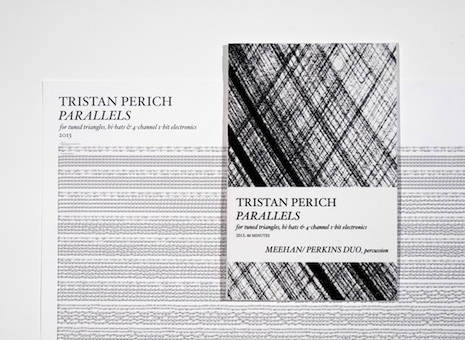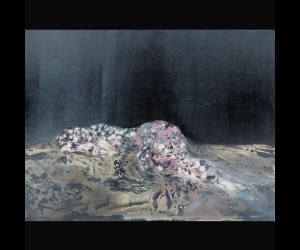
Across his body of work, composer and conceptualist Tristan Perich varies from electronoise and glitched-out video to sound installations and drawing machines. But what he is no doubt most known for is a singularly focused and wonderfully varied approach to composition. His “one-bit music” got a fair bit of attention with the release of a chip housed in a jewel case that would play this technically simple, structurally complex work, released by Cantaloupe Records in 2010. There, he stripped tonality from the eight bits of information used in simple video-game music and by audio art hackers to a single bit of information without nuance so much as volume control. It is simply tone switched on or off.
A line could easily be drawn from his work to the Philip Glass and Steve Reich stripe of minimalism. Like those elder NYC composers, Perich finds tension in repetition and the stacking and colliding of arpeggios. His most satisfying work pairs simple electronics with groups of like acoustic instruments. During 2015, Perich issued this four-disc set of his hybrid work on his own Physical Editions label. The nicely designed, oversized cardboard cases also contain scores reduced to the point of reflecting the music metaphorically.
At forty-six minutes, Parallels is the longest of the four (in point of fact, all four could have fit on two CDs). It’s also the most sublime. Written for electronics and percussion, it’s played with startling precision by the Meehan/Perkins Duo (Todd Meehan and Doug Perkins), whose cymbals and triangles fall perfectly in line in the electronic aural maze. Perich’s project isn’t about subsuming the human element but here the pair becomes the perfect man-machine. Telescope, a mere seven minutes in length, is a dramatic mesh of slow intervals, with four low reeds moving at about a quarter of the speed of the electronic tones, gently ringing like chimes in a soft breeze—if somehow metred.
Perich’s primary instrument, when he plays a conventional one, is the piano, and the strongest work he’s released to date is for electronics and keyboards: Surface Image, played by pianist Vicky Chow and released in 2014, remains his best recording. The invigorating Dual Synthesis, with Daniel Walden on harpsichord, is a close second. At core, Perich’s music is about rhythm, and pianos and harpsichords lend well to that. Dual Synthesis is like a mad telegraph dance, and is the most exciting of the 2015 releases. Active Field is the most conventional, opening with quick string pulsations, like a sonata waiting to happen. This time, it’s the machines that must conform. The string lines are played with warmth by a cadre of ten violins, the electronic tones hiding in the shadows for the first third of the piece before taking over in one of Perich's most gloriously Glass-like passages. He continues to mould and shape the ensemble dynamic, revealing layers of his methodology in the process. It’s not his strongest composing in the set, but it suggests the workings of his beautiful and unusual music.


